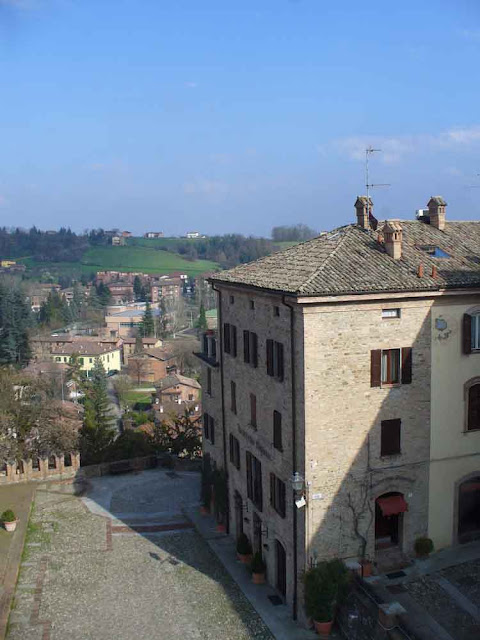....or, "In which I learn a great deal about balsamic vinegar."
I did not know, when I took this pic, that we would stand in the one window you can see in the tower just to the right of the middle of the image.....
We drove 'round, climbing the hill in the previous, to a parking lot at the top, and then walked toward the tower you can see at the end of the street in the next image. We didn't know, walking along here, that we'd climb that tower.....
Or that our extremely informative tour at La Vecchia Dispensa would begin in the orange building at the end of the street (on the left side of the street).
I hope and believe I am giving a faithful rendition of what I heard on the 9th.....
I knew exactly nothing about balsamic vinegar before April 9, other than I thought it was tasty.
I did not know that it was originally made as a tonic for health. If a child had an unhappy tummy, granny would give a spoonful of balsamico. The name comes from the concept of balm, or tonic. Every family in this area of Italy had their batteria of barrels for making their own balsamico. Balsamico was considered so important to a family's health and well-being that it was as precious to them as anything else they owned.
Over time, some families began to produce enough that they were able to sell a few bottles. No one who made their own balsamico would use purchased balsamico for their own family's health, as they were sure their own was better, but if people wanted a gift for a friend who did not make their own balsamico, they might buy some of someone else's (as they probably didn't have enough of their own production to share). In this way, production of balsamico for sale began.
It's hard to decide how to talk about balsamico tradizionale. Do I start from scratch, as a person would, if they wanted to begin trying to make balsamico, and describe the barrels and how they change from a raw new state into experienced producers of the precious tonic? Or do I jump into the middle of an established tradition and and assume an experienced batteria? Do I start with the difference between the tradizionale and the much cheaper vinegar sold as balsamico (without the crucial tradizionale)? When do I talk about making vinegar from fruit juice, directly, rather than from wine made from fruit juice?
I believe I'll start with the established tradition, and assume an existing and well-used batteria of barrels, perhaps like this one.
Balsamico tradizionale is made from the juice of grapes,
only. The grapes are pressed in the autumn, a bit later than grapes meant for wine are pressed. The freshly-pressed juice is
immediately boiled. It is cooked down a bit, so it is concentrated;
sweeter, and darker in color than the original grape juice. The "grape
must" (as the boiled juice is called) might go into the largest barrel in a
battery, or the family might have an even larger barrel, from which the biggest barrels in multiple batteries are filled.
Fermentation begins when the grape must is introduced to the
vinegar "mother" -- a culture which includes a microorganism which
changes the sugar in the grape must into acetic acid. The barrels in a batteria are never quite emptied; the mother is always in a barrel from the previous year, waiting for the introduction of more grape must (or nascent vinegar).
The vinegar stays in a given barrel for a year. It needs the seasons -- cold for part of the process, and hot for another part. Traditionally, a family's batteria would be kept in the attic, where it is cold in winter, and hot in summer. Of course it doesn't want to be too cold (no freezing) or too hot (if it's very hot and dry, the vinegar may evaporate, and the barrels are more likely to leak).....
Each autumn, the family's supply of balsamico for the coming year is removed from the smallest barrel. The person in charge of the balsamico (usually the oldest male), decides how to manage the barrels. It is often the case that the smallest barrel is refilled from the next smallest one, which is refilled from the next smallest one, and so on. The person in charge uses nose and mouth (and education and experience!) to decide how to refill the barrels within a batteria, balancing the flavor and aromas according to individual choice and preference.
The biggest barrel in a batteria is filled with new grape must, or perhaps is filled from a much bigger barrel, which has been holding grape must from the previous year for filling the largest barrels of several batteries.
One of the common themes touched on, as we visited producers of fine traditional foods, was the
amount of hand labor that goes into the making of traditional products. In the case of balsamico, that begins with the cooper who makes the barrels. This barrel is part of a brand new, never used, batteria. The barrels comprising a batteria are often made of different woods. Barrels are branded with the name of the wood from which they are made. This one is oak. Other barrels in this new batteria were made from chestnut, acacia, and cherry. Other woods might also be used. Using several different woods adds to the depth of flavor of the finished product.
There can be a long wait to receive new barrels after an order is placed, even for an established customer. Given that the process for making balsamico is driven by the seasons, and new grapes are available only in the fall, a delay in receiving barrels can mean up to a whole year's delay in beginning to bring a batteria online.
The
thickness of the barrel walls affects longevity (eventually the acid will
eat away the barrels to the point where they leak too much to be
useful). Thinner barrels can be brought into production faster, but they don't
last as long.... (Eighty years is usually an upper bound for the useful life of a batteria.)
Before new barrels at La Vecchia Dispensa are introduced to the vinegar mother, they spend a year full of wine vinegar. This pulls some of the harshness of the new wood out, and gets the wood ready to think about making balsamico. (The last clause is my words. I think they reflect the spirit of what I was told....)
I didn't think to ask how the barrels in a new batteria are filled as it comes online. I wouldn't be surprised if they are all filled with grape must, the first year after the wine vinegar, with the expectation that it will be years before anything delicious and health-enhancing comes out of that little barrel. But I don't know. Maybe the smaller ones stay full of wine vinegar for years, as the grape-must-turning-into-balsamico slowly makes its way from the biggest barrel to the littlest, one year at a time. Maybe it depends on the manager of the balsamico, or maybe it's usually done in just one way. I wish I'd asked.
After learning the basics of the production of balsamico tradizionale, and a bit about commercial products that have balsamico in their names but are not tradizionale, we left the room in which we began (in the building on the left), and went into the tower at right, which now houses many of La Vecchia Dispensa's batteries of barrels.
The tower was originally built to be a prison. (Hence the sparcity of windows, I bet.) We climbed up a very steep wooden staircase (close to being a ladder, but not quite), and from there, we climbed up a narrow spiral staircase carved out of stone. (Wish I had taken pictures as we ascended!)
At La Vecchia Dispensa, a new batteria is constructed every time a girl is born into the family. Clementina is grandmother to our host.
This wonderful bright room near the top of the tower contained many batteries of barrels, and had lots of family photos on the walls. We saw multiple pics of Clementina: as a girl, as a young mother, as a grandmother.
Here are some other batteries. You can see the big barrel from which the biggest barrels in the batteries will be filled.
The barrels are essentially never closed up tight, because the
mother-of-vinegar must breathe. They covered with a cloth to keep out
the bugs, and might have a rock sitting on the cloth, to keep out mice,
if mice are an issue where the barrels are stored. The irregular shape
of a rock lets the air in, while excluding the rodents. (There is a stopper for each barrel, to close it tight, but these are only used when the weather is very hot and dry, to stop the vinegar is evaporating too quickly.)
Our host removed the cloths from a couple of batteries, and encouraged us to stick our noses in and take a deep breath..........
I
was astonished that we were allowed to do that, and surprised to find that my entirely-uneducated nose could easily
tell the difference between the barrels. It was very interesting that
the difference between the barrels in a battery was greater than the
difference between the two smallest barrels in the two different batteries we sniffed.
What a cool thing to get to do.......................!!!
The plate on the floor, under a barrel in the image above, is there to catch the drops falling from a barrel that no longer seals quite tight. That vinegar is diluted, and used in summer to dampen the outsides of the barrels when the weather is very dry. That's one reason the not-new barrels are dark.
You can see there is a window in the top left corner of the previous image.... You know I couldn't resist the view from up there............... Looking north.
Looking east.
La Vecchia Dispensa's storefront is in the bottom of this building, with an awning over the door.
A closeup of the roof. Old tiles and chimneys, with tv antennas and skylights.....
Just a bit to the left -- clock tower.
Looking southwest.
The sun, blowing out the sky behind the church.
Looking south.
Remember I said this tower was built to be a prison? This is the door at the top of the spiral steps. This side of the door would have faced the guards, when the door was closed. I couldn't resist working the old latch, and opening the peep-hole.
I mentioned to our host that I was quietly thrilled to be allowed to play with this hundreds-of-years-old construction. In my practically-brand-new country, a thing like that door would be in a museum, not for touching!
He paused for a moment, and said that sometimes people were too close to something to appreciate it -- that to him, it was just a door. I told him I hoped he would share my perspective, once in a while, and see that door through my eyes.....
We came back down the spiral stairs, and the laddery stairs, and went into this building to taste vinegars.
I hadn't realized, until April 9th, that there are two completely different products available with very nearly the same name.
I hadn't understood there are two ways to make vinegar. You always start with something sugary. In Europe, vinegar generally begins with apple juice or grape juice. Then you have two choices as to how to get to vinegar. One choice is use a microorganism to turn the sugar in the juice into alcohol, and then use another microorganism to turn the alcohol into acetic acid. The other choice is to use a third microorganism to turn the sugar in the juice directly into acetic acid. (Now I am wondering what the advantages and disadvantages are to the two methods of arriving at acetic acid! I am concluding that the two-step method must be a lot easier and/or cheaper, as there are tons and tons of wine vinegar in the world for every half-liter of balsamico tradizionale!)
Balsamico tradizionale is grape must turned directly into vinegar. Aceto balsamico (vinegar which can be legally labeled as "balsamic", but is not tradizionale) can be up to 80% wine vinegar. Wine vinegar is not sweet, nor is it dark in color like balsamico tradizionale, so sugar and caramel coloring are added to make it seem more like balsamico tradizionale. Aceto balsamico (*not* tradizionale) may be tasty, but it is a totally different product from balsamico tradizionale.
Our tasting began with aceto balsamico which was not tradizionale. You taste the acidity first, and last, with the sweetness and flavor coming in the middle.
Then we tasted the balsamico tradizionale. Sweet first, then a burst of flavor, then, only at the end, the acidity......
Then we tasted the really, really good balsamico tradizionale. Wow. SO good. I would happily savor a spoonful of that every day. For my health. Mmmmmmmmm.
What a great tour that was. SO informative, so interesting. So many things I learned that I had never imagined. Thank you, Simone. I learned so much from you. Thank you.
Here is my daughter's take on our visit to La Vecchia Dispensa.
We took some pics before we strolled back to Ugo.
We saw this sort of shape at the top of fortifications, in many places. I wonder what the function is.......
The prison/balsamico tradizionale tower is just to the left of the buildings in the next shot.
You can see the checkerboard pavement in this open space, if you look at Google maps for Castelvetro di Modena with the satellite view turned on..... It's on the western edge of town, kind of in the middle the town, north/south-wise. Just south of the Via XX Settembre.
Looking around, as we begin to head back to Ugo.
Walking the other way on this street.
One last look in La Vecchia Dispensa's windows. Another brand new batteria, complete with rocks-on-top-to-keep-out-mice.
There's the new battery we saw in the early part of this post, behind the presentation boxes for balsamico tradizionale in the window.
The wooden box is complete with family photos. Google translates the writing on the box as "a treasure chest of family."
Happy sigh -- what a great afternoon!
In order to facilitate chronological traversal of these posts, here is a link to the next post.
.
Tuesday, April 09, 2013
Subscribe to:
Post Comments (Atom)














































No comments:
Post a Comment